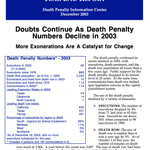The Death Penalty in 2003: Year End Report
Posted on Dec 18, 2003

OVERVIEW Top
The death penalty continued its recent attrition in 2003, with executions, death sentences, and the death row population all lower than a few years ago. Public support for the death penalty dropped to its lowest level in 25 years. At the same time, exonerations from death row helped spur legislative reforms in the capital punishment system.
The use of the death penalty declined by a variety of measures:
- EXECUTIONS: The number of executions dropped by 8% from 71 last year to 65 this year. Executions are down 34% when compared to 98 executions in 1999.
- DEATH ROW: The size of death row is smaller than it was a year ago by 5%. As of October 1 of this year, the number of inmates on death row stood at 3,504. A year before the count was 3,697. The size of death row had been increasing steadily after the death penalty was reinstated in 1976, but the numbers have declined since 2001.
- DEATH SENTENCES: The number of new death sentences is also declining, though the numbers for 2003 are still preliminary. The Bureau of Justice Statistics reported in November of this year that the number of death sentences for 2002 was 159, marking the fourth straight year of decline in death sentencing. DPIC’s assessment of death sentences for 2003 (based on data through Oct. 1) projects that the number of death sentences will be approximately 139, continuing the downward trend. The contrast is more pronounced (nearly a 50% drop) when compared to death sentences in the late 1990s, which averaged about 300 per year.
- REGIONALIZATION: The practice of the death penalty became more isolated in 2003. Only three states outside of the south conducted executions in 2003: Indiana, Missouri, and Ohio. Three states in the south, Texas, Oklahoma and North Carolina, accounted for 69% of the executions in 2003. All together, the south was responsible for 89% of the executions this year. Only 11 states carried out an execution in 2003, the fewest states in a decade. Two of the five states with the largest death rows had no executions in 2003: California and Pennsylvania.
- RACE: As has been the case for many years, those executed were almost exclusively guilty of murdering a white victim — only 18% of those executed were convicted of murdering a black person – despite the fact that blacks are victims in about 50% of murders in the U.S. In 2003, no white person was executed exclusively for the murder of a black person.
- INNOCENCE: In one area related to the death penalty, however, the numbers reached a highpoint since its reinstatement: ten people were exonerated and freed from death row in 2003, equaling the most exonerations in a single year since states began enacting new death penalty laws in 1973, and more than twice as many as last year. More cases are undergoing final review and may soon result in additional exonerations in Louisiana, Tennessee, North Carolina and other states.
- PUBLIC OPINION: Public support for the death penalty as measured by the Gallup Poll reached its lowest level in 25 years. Support dropped from 70% one year ago in October to 64% in October of this year, despite the media focus on the trials of two men accused of serial killings in Virginia and Maryland and continuing concern about terrorism. The last time support for the death penalty was lower was in 1978 when it measured 62%.
Tags